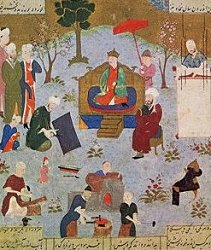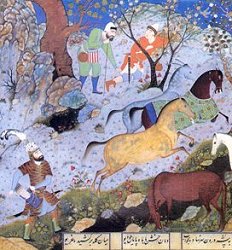Jamshid and Zohak [Zahhák]
.... The most famous of these legendary monarchs was Jamshid.2
To his credit is placed the building of Persepolis - termed to this day Takht-i-Jamshid or "The Throne
of Jamshid" - the introduction of the solar year, and the invention of most of the arts and sciences on which civilization is based.3 His invention of wine is stated to have been due to an accident. He had preserved some grapes which fermented and were believed to be dangerous to life. One of the wives of Jamshid was suffering from a painful malady and drank the fermented beverage in the belief that she would die; but, on the contrary, she fell into a delightful sleep and was cured. Persians from this date have termed wine "sweet poison" ....
Jamshid, after reigning for many years, was uplifted with pride.
He became a tyrant and declared himself a god. For his impiety the mystical Glory or Royal Splendour
was lost by the great monarch, as we read in the XIXth Yasht:
Ere he first to lies and untruth
Bent his thought and tongue...
Then before all eyes the Glory
Bird-like fled away from Yima. |

"King Jamshid Teaching Trades"
Shah-nama Ferdowsi |
Zohak, a Syrian prince, was incited by the Heavenly powers to attack him, and although he fled to Sistan, India, and even to distant China, he was in the end made captive by his relentless foe. He was put to a barbarous death, being fastened between two boards and sawn in two with the backbone of a fish. Zohak, at whose hands he perished so miserably, and who conquered Persia, is legendary, the name being a corruption of the primeval serpent, Aji-Dahak. In Persian legend he is represented as an Arab prince invading Persia from Syria, and as a monster from whose shoulders hissing snakes grew. The daily rations of these snakes consisted of the brains of two human beings; and the levying of this blood-tax led to the overthrow of the invader.
Feridun [Feraydun] and Kawa [Káveh]
Kawa, a blacksmith, whose sons had been doomed to feed the snakes, excited a popular rising,
and seeking out Feridun, a scion of the royal race, set him at the head of it. After many campaigns,
during which the blacksmith's apron4 was used as the
royal standard, Zohak was captured and chained up inside the crater of Mount Demavand [Mount Damávand],
there to undergo a lingering death...
The Three Sons of Feridun
According to the legendary history, Feridun had three sons. To Selm he gave the West, to Tur
the East (henceforward termed Turan); while to his youngest son, Erij [Iraj], he promised the throne
of Persia after his own death. This arrangement, not unnaturally, was displeasing to the elder brothers,
who threatened to invade Persia to make good their demands. Erij visited his brothers and
offered to resign his rights to the throne, hoping by this means to avoid civil war
during the last days of his father's reign. Selm and Tur, however, resolved to put Erij to death,
and refused to listen to his pathetic pleading for life, which as given by Firdausi [Ferdowsi], runs:
Will ye ever let it be recorded
That ye, possessing life, deprive others of that blessing?
Pain not the ant that drags the grain along the ground;
It has life, and life is sweet and pleasant to all who possess it.
Erij was murdered and... his head was embalmed and sent to the aged Feridun,
who was unable to avenge the crime. Some years passed and Manuchehr, son of Erij,
grew up and "attended by armies and clad in steel", killed both his uncles in single combat.
Sam [Sám], Zal [Zál], and Rudabah [Rudábeh]
Manuchehr succeeded his grandfather, and his chief adviser was Sam, Prince of Sistan,
who with his son Zal and his still more famous grandson Rustam, the Hercules of Persia,
fills the stage of Persian legend, even the kings playing but secondary parts.
None of these figures appear in the Indo-Iranian legends; but it is quite likely that they
embody a nucleus of truth, which succeeding generations overlaid with much fiction; and the
genius of Firdausi welded the whole into a grand epic. It is related that Zal was born with white
hair, which convinced Sam that the infant was not his own, but the offspring of
a Div.5
Consequently, he gave orders to expose it on Mount Elburz [Mount Alborz]; but it was nourished by the Simurgh, a fabulous mythical bird, and after a while Sam, hearing a divine voice, repented his conduct and recovered his son. Zal grew up to be a mighty warrior, and when hunting in the wilds of what is now Afghanistan, came to a castle where he saw Rudabah, the beautiful daughter of Mehrab, King of Kabul. It was a case of love at first sight on both sides, and the ardent lover scaled his mistress's tower by using her long tresses as a rope. |
Rustam the Champion
The offspring of the marriage of Zal and Rudabah was Rustam, the great champion of Iran,
whose fabulous exploits as a warrior, and a hunter still loom immense in the minds of Persians.
Closely connected with the hero was his horse Raksh, whose size and courage are legendary; in Sistan,
ruins situated a mile apart are pointed out as having been the "manger" and "heel-ropes" of Raksh!
Rustam's prowess was mainly displayed in the wars waged between Turan and Iran, which began
after the death of Manuchehr and the accession of his unworthy son Nozar, and lasted for more than a
generation. The Turanian leader was Afrasiab, who slew Nozar and ruled Persia for twelve years,
and this period of gloom saw the end of the Pishdadian Dynasty. |

"Rustam Recovers Raksh from Afrasiab's Herd"
Attributed to Mirza 'Ali |



